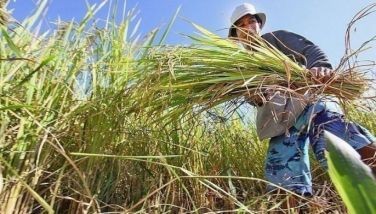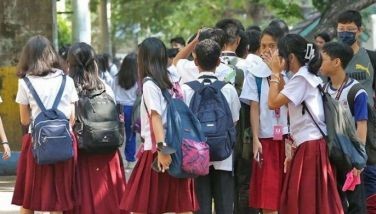The more, the merrier
June 27, 2004 | 12:00am
Aware of the increasing cost of fish feeds, fertilizers, and other farm inputs against the low market value of bangus and tilapia, Agriculture Secretary Luis P. Lorenzo Jr. has instructed the Bureau of Fisheries and Aquatic Resources (BFAR) to fast-track the implementation of its program on the use of polyculture technology.
Lorenzo said the incorporation of secondary high value species such as lapu-lapu, siganids and shrimps in bangus ponds will significantly enhance the income of the farmer.
He said that in instances when the income generated from harvested bangus is just sufficient to cover increases in operating expenses, under the polyculture scheme, the farmers could be assured of additional income from the secondary crops as these are of higher commercial value.
BFAR Director Malcolm I. Sarmiento, Jr. said that based on previous verification studies and experiments conducted by the National Brackishwater Aquaculture Technology Research Center (NBATRC), a facility of the BFAR in Pagbilao Quezon, there are at least five available polyculture technology options that are potentially profitable under the present economic conditions.
These technologies in brackishwater fishponds include (1) extensive culture of milkfish in combination with siganid and shrimp; (2) semi-intensive culture of milkfish in combination with siganid and shrimp; (3) extensive culture of grouper mixed with tilapia and mudcrab in partially developed brackishwater fishpond; (4) semi intensive culture of grouper with tilapia and mudcrab in fully developed brackishwater fishpond; and (5) semi-intensive culture of shrimp in combination with milkfish and siganid, Director Sarmiento said.
Sarmiento said species combination takes into consideration both the biological characteristics of the organisms and the sustainability of the technology. For instance, as bangus and siganids are both herbivores that feed on plant materials and occupy the water column, there is not much competition with the bottom-dwelling shrimps that feed on commercial pellets. On the other hand, the prolific tilapia mozambicus is combined with lapu-lapu as its offspring could serve as supplemental feed for the carnivorous lapu-lapu. Crabs could also be added to this combination as these feed on the scrap or left-overs that sink in the pond bottom.
NBATRC chief, Dr. Romeo E. Dieta said the choice of polyculture technology will depend on the present need, the prevailing cultured species in the locality and the sustainability of the pond for the technology option. He strongly suggests that prior consultation must first be made with the Regional BFAR offices regarding the selection of culture species suitable for the existing local environmental conditions.
Furthermore, before the fish is stocked, he said that it is very important that the pond is first repaired, prepared and grown with natural food. Once the ponds are ready, fish stocking will follow and the stock will be reared in accordance with the regular management and operational procedures. The stock will be harvested once they have reached the target size. After harvest, the ponds must be dried and prepared again, Dr. Dieta said.
Dr. Dieta hopes that these new polyculture options will improve brackishwater aquaculture development and eventually generate enthusiasm among local fish farmers therefore uplifting their livelihood and sustaining the country’s brackishwater aquaculture production. — BFAR FRMP-IPRG
Lorenzo said the incorporation of secondary high value species such as lapu-lapu, siganids and shrimps in bangus ponds will significantly enhance the income of the farmer.
He said that in instances when the income generated from harvested bangus is just sufficient to cover increases in operating expenses, under the polyculture scheme, the farmers could be assured of additional income from the secondary crops as these are of higher commercial value.
These technologies in brackishwater fishponds include (1) extensive culture of milkfish in combination with siganid and shrimp; (2) semi-intensive culture of milkfish in combination with siganid and shrimp; (3) extensive culture of grouper mixed with tilapia and mudcrab in partially developed brackishwater fishpond; (4) semi intensive culture of grouper with tilapia and mudcrab in fully developed brackishwater fishpond; and (5) semi-intensive culture of shrimp in combination with milkfish and siganid, Director Sarmiento said.
Furthermore, before the fish is stocked, he said that it is very important that the pond is first repaired, prepared and grown with natural food. Once the ponds are ready, fish stocking will follow and the stock will be reared in accordance with the regular management and operational procedures. The stock will be harvested once they have reached the target size. After harvest, the ponds must be dried and prepared again, Dr. Dieta said.
Dr. Dieta hopes that these new polyculture options will improve brackishwater aquaculture development and eventually generate enthusiasm among local fish farmers therefore uplifting their livelihood and sustaining the country’s brackishwater aquaculture production. — BFAR FRMP-IPRG
BrandSpace Articles
<
>
- Latest
Latest
Latest
November 9, 2024 - 3:43pm
By E.H. Edejer | November 9, 2024 - 3:43pm
June 9, 2024 - 5:55pm
By Alberto Peña | June 9, 2024 - 5:55pm
May 24, 2024 - 10:00am
May 24, 2024 - 10:00am
May 14, 2024 - 3:43pm
By Ian Laqui | May 14, 2024 - 3:43pm
April 10, 2024 - 5:12pm
By Ian Laqui | April 10, 2024 - 5:12pm
Recommended





























